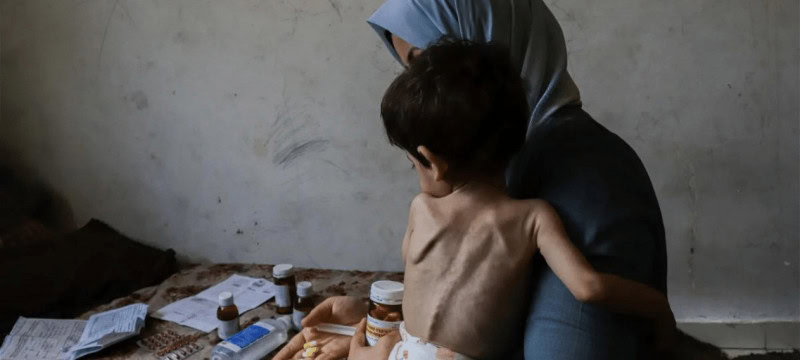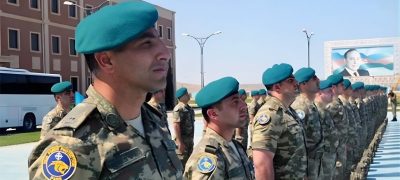Younis, a 9-year-old Palestinian boy, lies disoriented on a green mattress at Nasser Hospital in southern Gaza. His pale, sunken face with long brown eyelashes rests in his mother’s arms, revealing severe malnutrition and dehydration. His blue jogging bottoms hang loosely on his emaciated legs, and his tiny ribcage protrudes from an oversized orange T-shirt.
His mother, Ghanima Juma’a, pleaded for help, expressing anguish over her son’s deteriorating health amid their struggle to survive near the Al-Mawasi tent camp along Gaza’s polluted coastline. Forced to flee Rafah due to intensified Israeli attacks, they now face extreme hardships with limited access to food, water, or shelter from the scorching Gaza heat.
Read more: Gaza’s Health Crisis Exacerbated By Flies, Mosquitoes, Raw Sewage And Garbage
“We keep moving due to war and invasion… Life is unbearable,” she lamented. “We don’t even have a tent over our heads.”
Gaza’s health system, crippled by ongoing conflict, is unable to provide adequate care for malnourished children. Doctors are overwhelmed, turning away desperate parents seeking essential supplies like baby milk. Israel’s blockade exacerbates the crisis, hindering aid delivery and worsening conditions already strained by infrastructure damage and water shortages.
A recent report by IPC warns of impending famine across Gaza, exacerbated by the destruction of infrastructure and severe food insecurity. The UNRWA reports over 50,000 children needing treatment for acute malnutrition, with at least 34 deaths attributed to starvation.
The conflict, triggered by Hamas attacks on southern Israel, has resulted in extensive casualties in Gaza. Health officials report over 37,658 Palestinian deaths and 86,237 injuries from Israeli military actions.
Extreme lack of water
In Gaza’s southern region, Younis suffers in his mother’s arms, while in the north, children in the Jabalya refugee camp face prolonged food shortages. They line up at a water truck, sweat dripping down their faces as they navigate through debris-strewn streets.
Meanwhile, numerous Gazans gather to obtain water, with aid workers nearby serving thick, hot red soup from large pots.
Access to food and clean water is scarce. Residents in the north have reported resorting to drinking contaminated water recently, exacerbating dehydration and spreading diseases.
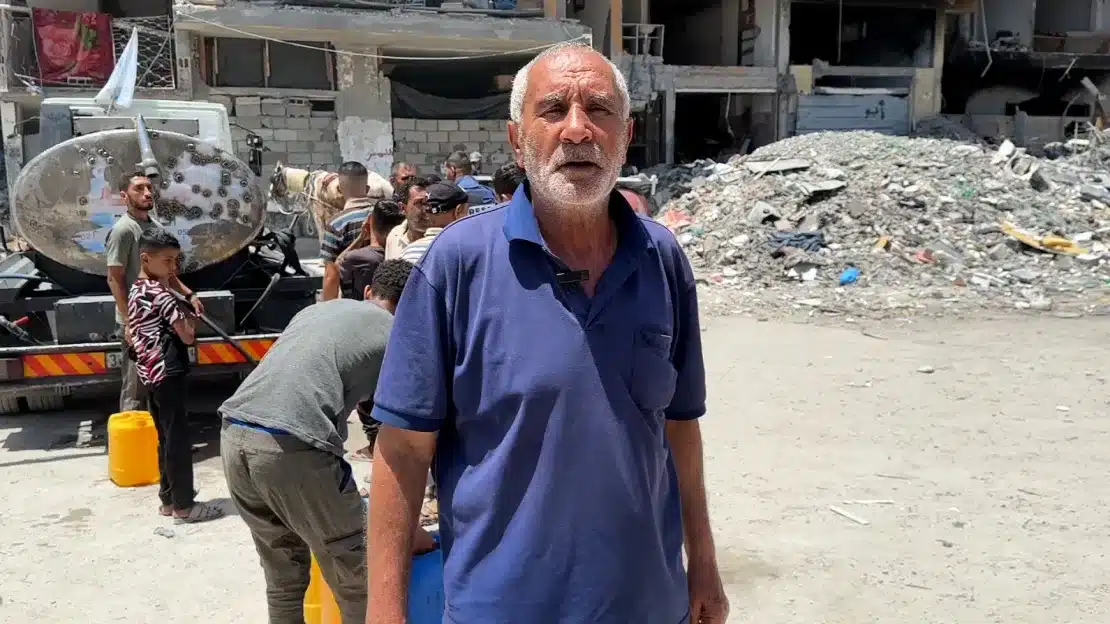
Israel asserts there are no restrictions on aid entering Gaza, but its stringent inspection procedures for trucks, limitations on land routes, and increased attacks are severely limiting relief efforts. Even when aid does arrive, the chaotic conditions and risks posed by hungry civilians scrambling for supplies hinder distribution. UN Secretary-General António Guterres recently highlighted the absence of law enforcement in Gaza during the conflict, leading to widespread lawlessness.
Earlier this year, the UN warned that Israel’s actions are causing a humanitarian crisis in Gaza through deliberate policies. Israeli Prime Minister Benjamin Netanyahu denied accusations from the International Criminal Court’s chief prosecutor that Israel is using starvation as a tactic of warfare.
“People here suffer immensely; the situation is beyond words,” said Hassan Kalash, a resident. “We are sick and lack the strength to fetch water… The water infrastructure is broken. Aid is our only source of water.”
Residents in Gaza told that they lack access to running water and rely heavily on scarce aid deliveries. UNRWA reported that 67% of water and sanitation facilities in Gaza have been destroyed or damaged during eight months of bombardment. Additionally, all five wastewater treatment plants in Gaza are non-operational, according to the UN Environment Programme.

The UN’s Office for the Coordination of Humanitarian Affairs (OCHA) has accused Israeli authorities of obstructing humanitarian access to northern Gaza. During the first three weeks of June, Israel allowed 36 aid trucks to enter Gaza, while another 35 were either denied, delayed, or canceled due to logistical, operational, or security reasons.
The impact is starkly evident on the ground. At Al-Aqsa Martyrs Hospital in central Gaza, 5-year-old Razan, adorned with a gold ring, suffers from red sores on her fingers. She lies exhausted on a trolley, her aunt, Um Razan Mheitem, lamenting that Razan has weakened and developed skin inflammation since the conflict. “We struggle to find anything for her. Prices are high, and items are scarce,”.
‘Awaiting their deaths, one by one’
Newborn babies and pregnant women in Gaza face severe risks of malnutrition and dehydration, according to aid agencies and health workers. Undernourished mothers are more likely to give birth prematurely, leading to newborn deaths due to low birth weight.
At Kamal Adwan Hospital in northern Gaza, doctors were unable to save baby Amal, who passed away just four days after her premature birth. Captured the moments before her death, showing Amal struggling to breathe in an incubator, her tiny pink toes covered in plastic tubes.
“These babies are dying. It is God’s will, but it is also caused by people,” lamented her father, Ahmed Maqat, to News Agency after her death. Samaher, Amal’s mother, had endured months of pregnancy without proper rest, food, or water, Maqat explained.
“Everyone in these beds is at risk of dying. We are waiting for them to pass away, one by one,” he added, his voice filled with sorrow. “We have no life.”
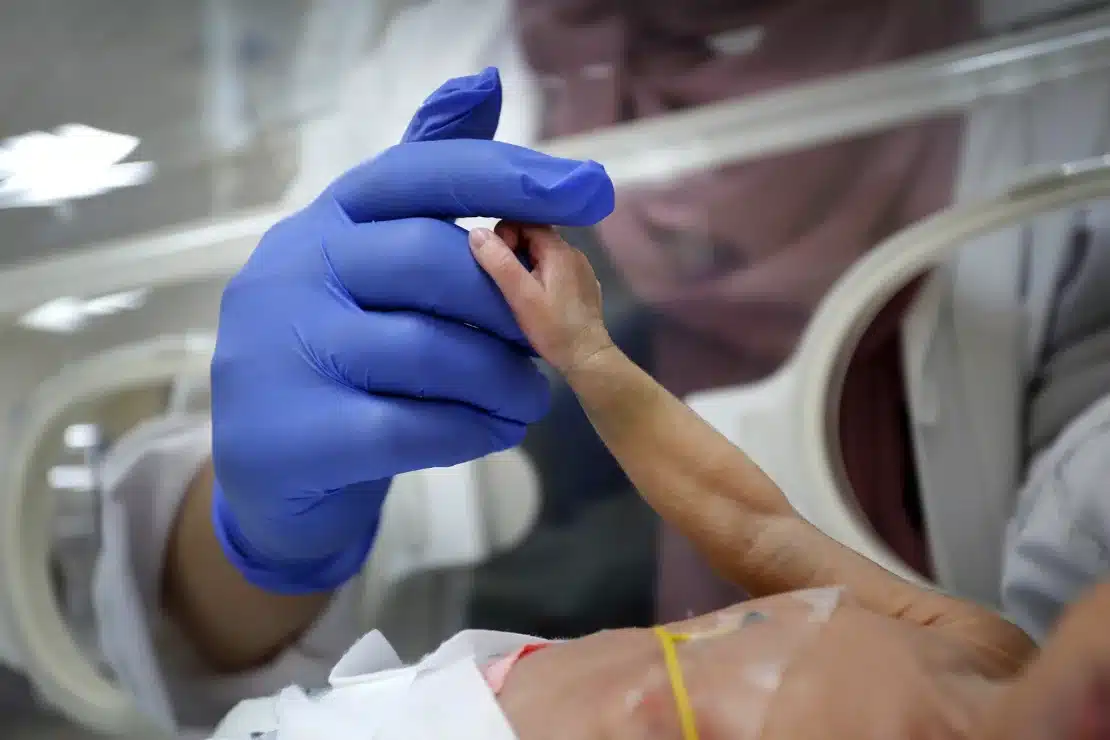
Dr. Ahmed Kahlot, head of the incubators department at Kamal Adwan Hospital, explained that due to Samaher’s poor health, her daughter was essentially “awaiting death.”
Many surviving mothers are too malnourished and dehydrated to breastfeed their infants. However, health workers informed that there are limited alternatives, with shortages of lactose-free or soy milk for babies.
Another Palestinian at Kamal Adwan Hospital shared that her 2-year-old son, suffering from an inflamed esophagus, cannot access the soy milk crucial for his condition. “He can hardly sit. He can’t crawl or walk,” she said.
Approximately 250 patients are currently receiving treatment for malnutrition at the hospital, with only two operational stabilization centers for severely malnourished children in Gaza, as reported by OCHA earlier this month. Nearly 3,000 children were receiving treatment for acute malnutrition in the southern region before the military escalation in Rafah.
Doctors frequently face challenges in treating malnourished infants displaying symptoms such as breathing difficulties, chest infections, and severe dehydration, amidst diminishing medical supplies. A local pediatrician told that malnourished patients with chronic or infectious diseases have reduced chances of recovery, exacerbated by the increase in disease transmission within displacement shelters. Since October 7, Gaza authorities have recorded over 1.4 million cases of infectious diseases, according to the Ministry of Health.
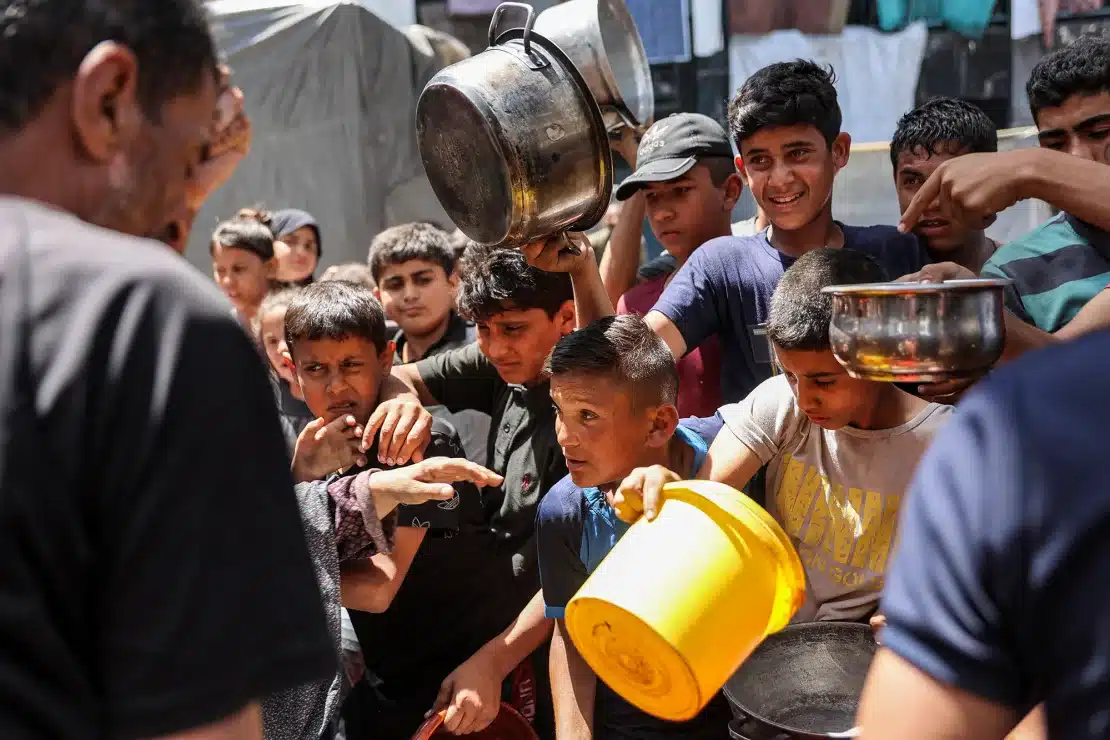
As hunger intensifies and parts of Gaza face imminent famine, aid agencies have consistently urged the opening of land crossings as the most effective way to deliver relief to the enclave. A US-built floating pier intended for aid delivery by sea has encountered numerous challenges, including adverse sea conditions and logistical issues upon transfer to land, failing to significantly alleviate the crisis.
In Khan Younis, Ismail Madi recently spoke about his grave concern for his 4-year-old son, Ahmad, suffering from jaundice due to malnutrition.
“My son cannot survive this,” he lamented. “I urge President Joe Biden to intervene to save this child, who is entirely innocent in any political conflict.”


